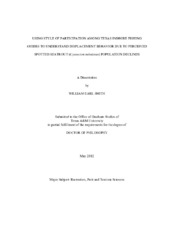| dc.description.abstract | Characterization of distinct angler fishing styles (e.g., how, where, and with what) allows resource managers the ability to predict how perceived impacts or modifications to fisheries resources (i.e., decline of fish species population) may impact different user groups. Recreation specialization provides a useful framework for understanding participation diversity among recreationists in terms of unique styles of participation. Bryan suggested that within an activity distinct types of participants exist that demonstrate characteristic styles of participation. Fundamental to Bryan's development of specialization were contextual attributes that characterize participant engagement in a recreation activity. However, advancement in specialization has been accompanied by a departure from Bryan's original conceptualization describing activity context. I revisited how specialization is operationalized and developed a contextual style of participation typology and self-classification measure to investigate displacement and substitution behavior among Texas inshore fishing guides.
Data were collected in two separate phases. In 2010, I conducted an exploratory investigation that included eighteen face-to-face, in-depth interviews with key informants spanning the entire coast. In 2011, I conducted a quantitative investigation that included mailing a 12 page self-administered survey to all Texas Parks and Wildlife licensed saltwater fishing guides (n=909). Thematic analysis drawing on grounded theory revealed that the salience of six contextual attributes (i.e., bait type, tackle type, fishing method, casting tactic, water depth, and fish species) that characterized four distinct styles of participation (e.g., Bait, All-purpose, Lure, and Sight-casting Guides). A unidimensional self-classification measure was developed based on my guide typology and discriminant analysis revealed it performed as well as a multidimensional measure of specialization. Ultimately, analysis of variance revealed significant differences existed among self-classification categories with respect to substitution behavior (e.g., targeting alternative species of fish, fishing in another location, and using alternative fishing methods or bait types) due to perceived spotted seatrout declines during 2010. In short, my findings suggest that anglers respond differently due to perceived spotted seatrout declines based on their preferred contextual style of participation. A contextual approach to understanding style of participation provides fisheries managers an effective method for understanding and mitigating social and ecological issues. | en |


